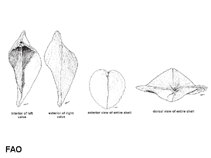Corculum cardissa (Linnaeus, 1758)
True heart cockle
رده بندی / Names اسامي عام | مترادف | CoL | ITIS | WoRMS
Bivalvia | Cardiida | Cardiidae
Environment: milieu / climate zone / تغييرات عمق / distribution range بوم شناسي
; تغييرات عمق 0 - 20 m (مرجع 348). Tropical
Distribution كشورها | مناطق سازمان خوار و بار جهاني (FAO) | Ecosystems | ظهور | معرفي
Indo-Pacific: from Mauritius Island, but probably not on the East African coast, to eastern Polynesia; north to Japan and south to northern Queensland and New Caledonia.
Length at first maturity / Size / Weight / سن
بلوغ: Lm ? range ? - ? cm Max length : 8.0 cm SHH جنس نر / بدون خواص جنسي; (مرجع 348); common length : 5.0 cm SHH جنس نر / بدون خواص جنسي; (مرجع 348)
Life cycle and mating behavior بلوغ | تولید مثل | تخم ریزی | Eggs | Fecundity | Larvae
مآخذ اصلی
مراجع | هماهنگ كننده | همكاران
Poutiers, J.M. 1998 Bivalves. Acephala, Lamellibranchia, Pelecypoda. p. 123-362. In Carpenter, K. E. and V. H. Niem. 1998. FAO species identification guide for fishery purposes. The living marine resources of the Western Central Pacific. Volume 1. Seaweeds, corals, bivalves, and gastropods. Rome, FAO. (مرجع 348)
وضعيت در فهرست قرمز IUCN
(مرجع 130435: Version 2025-1)
وضعيت از نظر سايتس (مرجع 108899)
CMS (مرجع 116361)
خطر برای انسان ها
استفاده انسانی
| FishSource |
ابزارها
اطلاعات بيشتر
تركيب غذايي
مصرف غذايي
شکارچیان
منابع اينترنتي
BHL | BOLD Systems | CISTI | DiscoverLife | FAO(Publication : search) | Fishipedia | GenBank (ژنوم, نوکلئوتيد) | GloBI | Gomexsi | Google Books | Google Scholar | Google | PubMed | Tree of Life | Wikipedia (برو, جستجو) | Zoological Record



